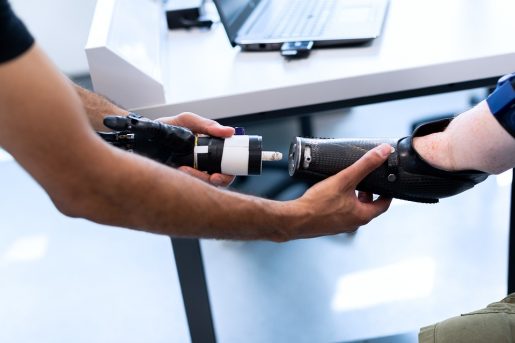Next-gen prosthetics: Ethically pioneering ideas and futuristic opportunities
We can all name a TV show or movie character who has a prosthetic limb: Imperator Furiosa’s arm from “Mad Max: Fury Road,” Bucky Barnes’ arm from the Marvel Cinematic Universe and Hiccup’s leg from “How to Train Your Dragon.” All these characters’ prostheses typically function just as well or sometimes better than their anatomical limbs. Current research and development in machine learning, sensory restoration and active-powered joints are bringing these once-imaginary technologies closer to reality, impacting the nearly 1.7 million people in the United States who use a prosthetic limb.
Even with these revolutionary developments, there are still great ethical concerns about emerging prosthetic technologies that need to be considered. In collaboration with Baylor College of Medicine’s Orthotics and Prosthetics Program, Center for Medical Ethics and Health Policy and Interdisciplinary Consortium on Advanced Motion Performance Lab (iCAMP) as well as University of Washington’s Department of Rehabilitation Medicine, we analyzed the current state of research in the field of prosthetics. We proposed important ethical considerations to guide the future development of safe and effective advanced prosthetic technology. 
There are many individuals involved in the development of new prosthetic technology, including researchers, manufacturers, clinicians and, of course, the end users. Our goal with this paper was to help identify and eliminate the silos between these stakeholders to expedite translation from initial conception to clinical application ethically. We emphasized the importance of including the opinions, needs and ideas of those who will use prosthetic technology early in its development, otherwise known as user-centered design.
We proposed that user-centered design frameworks are essential for developing new prosthetic technology that suits the needs of those with limb loss and limb differences and prevents wasted resources in the development of undesirable technologies.
Additionally, we highlighted the need for clinicians’ perspectives in development as well as the importance of promoting health equity for all patients (i.e., ensuring access regardless of socioeconomic status or geographical location). Furthermore, we discussed the challenges that researchers and developers must overcome to launch their technologies on the market, including insurance coverage, regulatory standards and patient privacy/protection.
Working with a multidisciplinary team of experts in ethics, clinical prosthetic practice, prosthetic research, wearable technologies, artificial intelligence and machine learning was very rewarding. Every author brought a unique perspective to help ensure all aspects of prosthetic technology development were accounted for and provide the reader with as much information as possible. We hope that this paper will be helpful, lead to more informed discussions and decisions and spark even more innovation in prosthetic technology that will truly benefit those who need it.
By Hayden Gavette, student, School of Health Professions, Baylor College of Medicine



